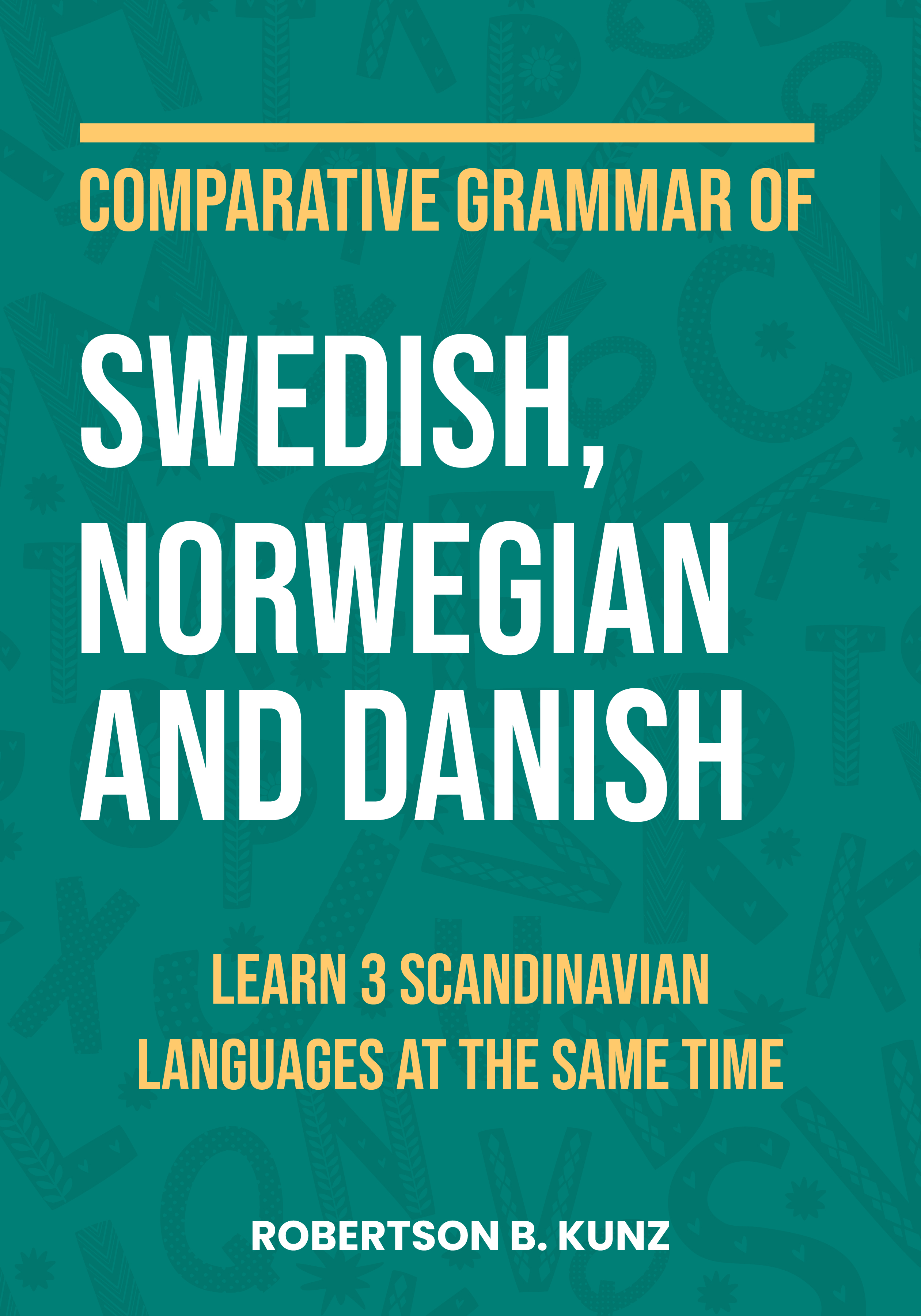Learning Swedish, Norwegian and Danish simultaneously?
 If Scandinavian languages are your thing, this book is for you: “Comparative Grammar of Swedish, Norwegian and Danish, Learn 3 Scandinavian Languages at the Same Time” Robertson B. Kunz, 2024. It is available on Amazon.com.
If Scandinavian languages are your thing, this book is for you: “Comparative Grammar of Swedish, Norwegian and Danish, Learn 3 Scandinavian Languages at the Same Time” Robertson B. Kunz, 2024. It is available on Amazon.com.
Learning a couple of new languages at the same time can be a challenging task, but Robertson Kunz shows that there are real advantages to doing it that way.
Most people learning more than one language experience mixing them up, especially if the languages are quite similar. How can you speak your new languages with some fluency, without rehearsing each statement before you speak?
That's a question I've been struggling with too, but I think Robertson book has given me a technique that looks promising.
In his introduction, Robertson talks about “practicing keeping [the languages] apart” as a skill that you can practice, and get good at. We'll have a look at that.
You could use this book for learning all three languages, or if you know one or two already, for adding the second, or third.
Robertson notes that he was "greatly influenced by Professor Alexander Agüelles in his view that languages should be studied in language families rather than one at a time." Professor Agüelles is also known for a method called "Language Shadowing", which we discussed in our earlier blog post "Will Language Shadowing Work for You?"
How the Book is Structured:
The first hundred pages of Robertson's book consists of several interesting introductory sections, which talk about about the languages, their evolution, the dialects, important historical and political events, the phonology of Swedish, Norwegian and Danish, as well as their mutual intelligibility, and more.
Following this, the book is divided into nine grammatical topics.
1. Nouns 2. Adjectives 3. Pronouns 4. Verbs 5. Adverbs. 6. Prepositions 7. Conjunctions 8. Comparisons and Superlatives 9. Numerals
Each of the topics has a number of short and clear grammatical explanations comparing the languages. These are each followed by numerous “identical” phrases in English, Swedish, Norwegian and Danish.
The Skill of Keeping Languages Apart
According to Robertson, it's practicing the side-by-side phrases, which is the key to learning how to keep the languages apart. In one of his YouTube videos, the author suggests that you “Write out phrases next to each other … read them many times … [and] practice switching back and forth between them.”
To give you an idea what such a practice could look like, here are two examples, one from the beginning of the section “Nouns” and one from the beginning of “Adjectives”. Each section has numerous side-by-side phrases in English, Swedish, Norwegian and Danish.
By trying out these phrases yourself, you'll have an idea of how this approach would work for you.
Definite and Indefinite Nouns:
English: I have a cat. The cat is black.
Swedish: Jag har en katt. Katten är svart.
Norwegian: Jeg har en katt. Katten er svart.
Danish: Jeg har en kat. Katten er sort.
Other topics in the “Nouns” section:
• Countable and Uncountable Nouns
• Plural Forms of Nouns
• Genitive Case of Nouns
Adjective and Noun Phrase Agreement:
English: a beautiful city
Swedish: en vacker stad
Norwegian: en vakker by
Danish: en smuk by
Other Topics in the “Adjectives” Section:
• Types of Adjectives
• Predicative and Attributive Adjectives
• Adjective Negation
• Adjective Order
• Adjectives in Plural Form
Learning the Pronunciation
On page 5, you can download a “Free Gift”, an audio file “to hear Swedish, Norwegian and Danish spoken back to back to get a better sense of these three languages.”
Learning the correct pronunciation right from the beginning is the best way to go. So, it's probably worth using another program, a friend or tutor, or an AI tutor for regularly practicing the sounds and intonation of your new language(s), and specifically for how to pronounce each of the sentences.
Language Switching
For me, language switching happens all the time in the four languages I live with every day: German, English, Dutch and French. I talk and text with family and friends. I'm not perfect, but I don't worry much about mixing up the languages. French and Italian a not a problem either.
But some time ago, I learned essential travel phrases in Norwegian, Swedish and Danish before visiting each of the countries. Now, a few years later, I do find it a little difficult to keep them apart. So, I'm excited about relearning the basics of these languages by switching between them as presented in the book.
Good Advice
The method in this book is pretty straightforward. But of course, learning a language does involve time and persistence. And so you'll probably agree with Robertson when he says: “The biggest obstacle you will face is not so much the learning of multiple languages at once as it will be your time management and ability to manage your emotional state."
With all this hype about "Learn a language Fast", it's interesting to see Robertson - a polyglot who actively works on 8 languages a day - say the following: “Ultimately, learning any language is a lifelong process and a slow one at that. If you are able to study a little bit each day, one day you will wake up and you will be quite good; although you may never notice yourself reaching that level.”
Disclaimer
I was contacted by Robertson B. Kunz to write this review. In return, I was offered a digital Review Copy of the book. We have no financial agreement about sales of the book.
